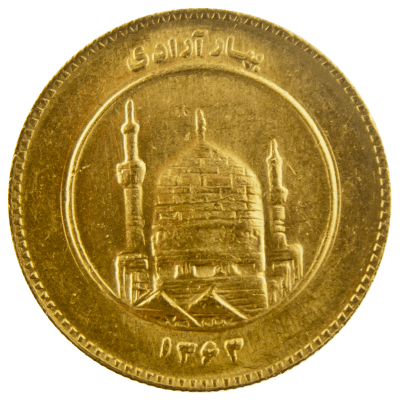Introducing the Bahar Azadi Gold Bullion Coin

The Bahar Azadi coin is a gold bullion coin minted by the Central Bank of the Islamic Republic of Iran. The coin was first minted in 1979 following the Iranian Revolution and replaced the Pahlavi coin which was named for the Iranian Royal family and previous controlling regime in the country.
Photo by David StanleyThe name of the coin literally translates to “The Spring of Freedom” and symbolises the coming of freedom from the monarchy that was brought with the revolution.
The Bahar Azadi coins feature different designs depending upon whether they were minted before 1989 or after that date. The pre 1989 coins feature a geometric design on one side and a mosque design on the other with the calligraphic script reading the Central Bank of the Islamic Republic of Iran and Bahar Azadi.
The design changed post 1989 to commemorate the death of Ayatollah Ruhollah Khomeini and these coins feature on the reverse a similar mosque design to the earlier coins and the calligraphic script reading the Central Bank of the Islamic Republic of Iran and Bahar Azadi. On the obverse the coins feature the face of Ruhollah Khomeini, the Ayatollah who led the 1979 Revolution to overthrow the Shah of Iran and subsequently founded the Islamic Republic of Iran. Following the establishment of the state he was proclaimed supreme leader, the highest position in both politics and religion which he held until his death in 1989.
Coins minted in 1979 may be referred to as The First Spring of Freedom or The First anniversary of the Revolution coins and feature the calligraphic script to reflect this.
History of the Central Bank of the Islamic Republic of Iran
The Central Bank of the Islamic Republic of Iran was founded in 1960 to provide a central Bank for the administration of government financial transactions and replace the acting central bank the Bank Melli which had informally held the position since its founding in 1927. The Central Bank was renamed immediately following the Iranian Revolution to include the existing name and add the Islamic Republic of Iran into the formal title.
The Central Bank of the Islamic Republic of Iran operates a museum in Tehran which holds historic and ancient jewellery once used by the Kings of the Persian Empire and also the Imperial Crown Jewels.
The Iranian Calendar
The calendar used by Iran and Afghanistan is different from that used in the western world and this can cause some confusion when dealing with striking dates of Iranian currency. A simple way of converting the date of the Iranian calendar to its Gregorian equivalent is to add 621 to the Iranian date given, for example the year of the Revolution is given as 1358 in the Iranian calendar and this corresponds to 1979 when converted to the Gregorian calendar by adding 621.
The Iranian calendars are amongst the longest continuous calendars in the world lasting for over two millennia in Persia and modern day Iran. The calendar currently in use is known as the Solar Hijri calendar, in literature this is commonly abbreviated to SH following a number denoting the year so 1979 would be 1358SH. The calendar is similar to the Gregorian calendar used in western nations in that the year is split into 12 months of similar length to their western counterparts. The calendar uses the Iranian names for the signs of the zodiac for its month names.
The calendar also differs in the determination of its start and end point. The Solar Hijri calendar is based upon astronomical observation and not simply mathematical determination of its beginning and end. The new year in the Solar Hijri calendar is linked directly to the Vernal Equinox which occurs in spring around the 21st March using western calendars.
The start of the new year is the prompt for 13 days of celebrations called Norooz, quite literally new day. These celebrations are analogous to the celebrations associated with the end of Winter and the coming of Spring as celebrated by many other cultures around the world. The Calendar recognises its official beginning as the year 621CE (Common Era or 621AD) Many believe this event to correspond to the migration of the Prophet Muhammad to the present day city of Medina to escape an assassination plot.
For Collectors and Investors
The Bahar Azadi coin is a comparatively unheard of and a rare coin in the west due to the complicated political issues that arose following the Iranian Revolution. They are therefore appealing to collectors and availability is strictly limited around the web.
They are of course also a way for investors to add precious metals to their portfolios however the gold content is not as high as the other popular investment coins from around the world at only 90% purity when compared to other coins which are available at 99.99% purity meaning that other options may be more appealing to the investor.
Sizes of Bahar Azadi coins
As noted above Bahar Azadi coin designs changed in 1989 to commemorate the death of Ayatollah Ruhollah Khomeini however the dimensions and weight remain the same.
Please note that due to limited availability these coins are offered on an as available basis and no guarantees can be made regarding the future availability of these coins.
The Bahar Azadi is struck in the following sizes at 90% purity of gold:
- 5 Azadi – Weight 40.7g, Diameter 40mm
- 2 ½ Azadi – Weight 20.34g, Diameter 30mm
- 1 Azadi - Weight 8.13g, Diameter 22mm
- ½ Azadi - Weight 4.068g, Diameter 19mm
- ¼ Azadi - Weight 2.034g, Diameter 16mm
Buy Now
There are no products matching the selection.